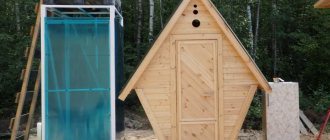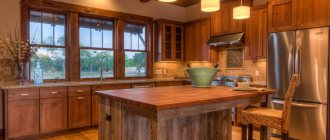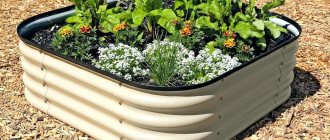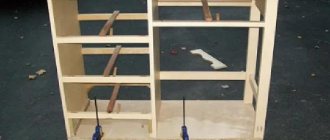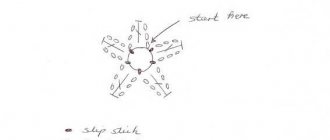Style and size of waterfall in the country
The terrain of the site and its dimensions significantly influence the formation of the landscape water composition. An area with a difference in ground levels is an ideal place to create a waterfall. On a flat area, you need to artificially create uneven terrain.
The size of the garden area determines the dimensions of the water structure. The waterfall should fit organically into the compositional design of the landscape design. A large water feature on a small summer cottage looks somewhat ridiculous and fits naturally into spacious properties. A small artificial waterfall will become part of the recreation area. A large area provides a lot of room for design solutions and overall dimensions.
Beautiful waterfall for the garden Source prom.ua
Style
The stylistic design of a waterfall in a country house or a personal plot depends on the design concept of the landscape and the house. Design style:
- Minimalism presupposes clear geometric shapes and laconic decor. Evenly flowing streams of water from smooth slabs of cascades into the bowl of a geometrically shaped pond look organic. Dry waterfalls are suitable for such a landscape. With smooth outlines of cascades and streams falling from them. Island waterfalls in a minimalist style look interesting. A cubic, spherical-shaped hill is mounted in the center.
Waterfall with a figurine of a pink flamingo Source www.youtube.com
- Classical. Decorations in the form of statues and amphorae are characteristic features of the classical style. A common design technique is an island waterfall in the middle of a round pond. Decorative elements inherent in the classical style are installed on the cascading ledges.
- A natural waterfall is as close in appearance as possible to natural compositions. Part of the natural landscape is being recreated. The shape of the bowl of the pond, the hill from which the water flows, is given by natural uneven shapes. Natural materials, mainly stone, are used for the construction of structural elements and decoration.
The choice of shape, type, and decoration methods directly depends on the tastes and preferences of the owner of the personal plot. A decorative waterfall on a site is often the main focal point of the landscape. In a large area, an artificial waterfall will decorate the recreation area.
Original decoration of an artificial waterfall Source stroy-podskazka.ru
Decorative decoration of the waterfall
This stage is the final stage in the construction of decorative waterfalls. The most interesting ideas used in practical design today:
- Planting moisture-loving plants on cascading plateaus.
- Arrangement of water lilies in shaped pots on underwater plateaus. Water lilies are one of the few plants that prefer to live under water.
- The use of garden figurines located on cascades.
- Formation of stone sides along the water flow.
An original idea is to use multi-colored stones located along the bottom of a dry waterfall. Such colored elements can be purchased at any hardware store, for example, in Leroy Merlin.
Choosing a place for a waterfall
The location of the waterfall is determined by several factors. Among them:
- Goal setting, landscape design concept. Will the waterfall be the focal point of the landscape, or a component of a local area? Most often, an artificial waterfall in a dacha or local area is built near a recreation area. It is advisable that it be viewed from different points, windows of the house.
- Technical points. It is undesirable to place the object in direct contact with the wall of the house due to high humidity and water noise. If the tightness of the structure is broken, moisture can penetrate the wall or foundation, which will provoke the formation of mold. If you install a small waterfall in the corner of the site, between the fence and the house, it is recommended to move the structure away from the wall. But a small water feature near the porch of the house is quite appropriate, it looks interesting.
- Natural factors. It is advisable to locate water structures in an open area away from large trees and shrubs. Falling leaves clog the pond. It is better to plant evergreen shrubs near an artificial waterfall. If the water gets very hot in the sun, there is a risk that it will bloom and turn green. The reason will be a sharp increase in the phytoplankton population. It is advisable that the sun illuminates the waterfall before noon.
Waterfall from improvised means Source novamett.ru
It is recommended to additionally install garbage traps in the pond bowl. Foliage and branches are blown by the wind, even if there are no deciduous trees or shrubs nearby.
When you have decided on the location, size and style, you need to think about the type of water structure.
Types of waterfalls
The principles of design and construction of waterfalls are similar, but each type has its own nuances. Main types of waterfalls:
- cascade - water falls from several levels (minimum 30 cm);
- flow type - water flows smoothly along low, oblong, almost even steps of the cascade;
- “dry” waterfall - water flows not into the bowl of a pond or pool, but into a covered container;
- waterfall “wall” - two types: water flowing over glass; smooth flat stream, water wall of the grotto;
- waterfall without a pump, 2 types: according to the type of communicating vessels; with a natural source.
Large reservoir in stones Source topiar.ua
The choice of design type is determined by personal preferences, style and features of the relief.
As for the cascade type, the design of the water structure depends on the height of the cascade, the size of the bowl, and the volume of pumped water. The higher the height of the steps, the more powerful the pump is needed to supply water. A cascade structure up to 1.5 m high and steps up to half a meter wide requires a pump with a capacity of up to 80 l/min. For cascades with a height and width of steps greater than 2.5 m, a pump power of 450 l/min is required. The pump is purchased with a partial power reserve. Some is lost to boost the water pressure and filter resistance.
Alpine slide with a waterfall Source luckclub.ru
Choosing a waterfall scheme
We decide on the desired height. The waterfall must be located on a hill; if it is absent, then make it artificially. The number of steps will depend on the height. Then we determine how many waterfalls are needed. It can be done with upper and lower mirrors, but such a project will require a rather large area.
The easiest way is to make a waterfall like a falling stream. The circulation system will be located inside a building made of stones.
How to make a waterfall with your own hands: stages of construction
Bowl of the pit. Usually they make 3 tiers of a pit, each of which is smaller in perimeter than the previous one: 1 - the main perimeter; 2 - for fixing the roots of aquatic plants; 3 - for possible wintering of fish.
Preparation stages:
- the outline of the structure is drawn on the site;
- drive in pegs at intervals of 25-30 cm, stretch construction thread over them;
- outline the outline using sand, chalk, or a spray paint;
- they dig out a stepped pit;
- the earth is compacted;
- the bottom of the pit is sprinkled with crushed stone and sand (10-15 cm each layer), watered with water, and compacted again;
- line the bottom of the pit with geotextiles (prevents soil erosion);
- line the pit with a waterproofing layer (with an overlap around the perimeter of up to 70 cm) or concrete it.
Structure adjacent to the wall Source stroychik.ru
Please note: for large ponds, reinforcement of the foundation pit is a mandatory element, since the soil may subsidence under the weight of water.
The overlap of the waterproofing layer is necessary to prevent it from slipping under the influence of the mass of water. Along the edges, the waterproofing layer is secured with stones. Sprinkle with sand and gravel. Install pots with moisture-loving plants.
Water cascade on a personal plot Source vosledoma.com
Construction of a waterfall
The entire planning stage can be called a preliminary design, at the end of which there should be complete clarity in the choice of location, type, shape, size, materials and equipment for the waterfall. And the preparatory stage of arranging a waterfall begins with markings on the ground.
Marking, excavation, waterproofing
Work at this stage is carried out in the following sequence:
- Markings are carried out on the ground using traditional pegs and cords.
- Mark the contour of the future waterfall, taking into account the mirror of the reservoir at the base and the bed of the stream (if it is provided as part of the composition). They do this with a reserve, as for the foundation - the weight of the structure will be significant, and here it is impossible to do without laying a serious foundation made of stone, concrete or rubble concrete.
- Mark trenches for utility networks: water supply, power supply cables, sewerage pipes.
The last point is important - water is discharged into the sewer when the waterfall is preserved for the winter. In the case where there is no central sewerage system on the site, the water is discharged into a storm drainage well or a septic tank filter well. If they are located far away on the site, then they lay their own well to receive waste water next to the waterfall. When equipping a waterfall with a surface pump, a pit for the caisson is provided. - They dig a pit for a reservoir bowl. You can choose ready-made plastic containers that provide complete sealing. But they, as a rule, have a small volume and a rather limited range.
For individual projects, special reinforced PVC films are usually used as waterproofing, which are also used for swimming pools. - Remove the top layer of soil inside the perimeter of the base of the waterfall. It is folded separately; in the future it will be useful for forming side slopes along the stream bed.
- Lay trenches for pipes, pump power cables and lighting.
- They compact the bottom of the pit and trenches, and fill them with a sand or sand-gravel cushion. If a cascade of several riffles is planned on the slope of a site, check that the slope is maintained along the channel from the source of the artificial stream to the reservoir.
- When the relief of the reservoir is specified, a bowl or waterproofing film is placed on the bottom of the pit. The riverbed is also waterproofed if the waterfall is installed as part of an artificial stream on the natural slope of the site.
Pump connection
Formation of a waterfall
At this stage, three construction options are possible:
- Laying of natural stone of an original composition in the form of a rock (hill).
- The use of treated stone or ordinary building materials to construct cascades or a single wall in which a stream of water falls from an opening.
- A combination of the first two options - the use of natural stone and ready-made forms. Moreover, in addition to processed stone or concrete slabs, special vessels (amphoras, jugs) and even sculptural compositions can act as ready-made forms.
When forming a waterfall or cascade, all elements of the structure are securely fastened with a cement-based solution with hydrophobic additives. The seams in the channel must be treated with sealant in order to reliably protect the entire path of the water flow from leakage.
During the construction of the hill, a spout is laid at the top, to which a water supply is laid between the masonry elements. If there are several flows, then a separate pipe is connected to each source.
In the case where plants and herbs are planned to be planted along the waterfall, a geogrid is laid and secured on the side slopes of the hill, the cells of which are filled with earth. When creating the image of a rocky hill, wild stone is placed in the cells, held together with cement mortar.
Waterproofing
An important element of the pond design. An inexpensive, but not reliable enough method of waterproofing is several layers of clay. Under the influence of temperature changes, cracks and ruptures of the pit bowl may appear.
Types of waterproofing:
- PVC film is an affordable material, but not durable. Narrow canvases are connected using adhesive tape using a floating method. Will last 1-2 seasons.
- Butyl rubber is a synthesized, rubber-like polymer of isobutylene. Reliable film, service life 45 - 50 years. The coating is resistant to temperature changes.
- Liquid rubber is applied to geotextiles and sprayed over the surface. Guaranteed service life up to 20 years.
- Waterproofing made of polyurethane. Elastic, resistant to temperature changes, with a long service life.
- Durable and reliable concrete bowl.
The main decoration of the site Source buildhouse.info
In parallel or simultaneously with digging a pit, they make a hill for a waterfall cascade. It is easier to turn a relief with a drop into a stepped cascade. It is enough to trim it, give it shape, compact it. Sprinkle with crushed stone, sand, and compact again. If the height of the steps is higher than 30 cm, it is advisable to additionally cement the structure
Preparation stage Source luckclub.ru
It is more difficult to build a cascade on a flat surface. The land removed from the pond pit will come in handy. Frame steps are formed from it, each ledge is compacted. Strengthen the perimeter of the steps with layered savage bricks. The surface of the steps is reinforced with a cushion of crushed stone and sand and filled with cement mixture.
A gentle waterfall is built according to the same principle. Only the cascade steps are made wide and flat.
The type of falling stream depends on the type of side of the cascade steps from which the water flows. A split flow occurs when the edge of a step is uneven if obstacles made of stones are installed on it. The smooth edge of the step with a special groove creates an even flow.
Construction with wooden elements Source re-home.su
Construction of a reservoir
When building a waterfall, there is no way to do without constructing a reservoir. The easiest way, of course, is to purchase a plastic mold designed specifically for this purpose. In this case, all you need to do is dig a pit corresponding to the outline of the container and immerse the bowl in it.
If, due to certain circumstances, this method is not acceptable to you, you will have to do excavation work. To do this, outline the outlines of the future reservoir on the ground. Very often, preference is given to curvilinear shapes with smooth contours, but it is not always possible to draw such an object the first time.
To make your task easier, take a flexible hose or rope and lay it out in the form of a contour. The advantage of this method is that you can adjust the boundaries of the future reservoir an infinite number of times.
When the desired result is achieved, secure the hose by pinning it to the ground, or outline the boundaries with sand/spray paint. If you are planning a multi-level bottom with steps, it is advisable to mark the outlines of the ledges in the same way.
Mark on the surface of the earth the location of the hill for the waterfall, along which the water will flow. You can start excavating the soil. After the pit for the reservoir is ready, pour a 10 cm thick layer of sand onto its bottom and compact it thoroughly.
It's time to waterproof the pond. Lay a layer of geotextile over the entire surface of the reservoir bowl to prevent the penetration of plant rhizomes, and put a butyl rubber membrane on top of it. This method of waterproofing a pit is the most durable; many membrane manufacturers guarantee a shelf life of butyl rubber material of up to fifty years. However, you can replace it with PVC film, but preference should be given to all-season samples that can withstand all kinds of natural mines for several years.
Please note that waterproofing is laid not only on the bottom and banks of the future reservoir, but also under the stone hill along which a decorative waterfall will flow. Otherwise, you will experience constant fluid loss.
Garden fountains for the dacha - tips for choosing and using in the design of the garden and site. 135 photos of the best options for placing modern fountainsDIY decorative flower beds: 165 photos of beautiful design ideas and rules for decorating the garden and surrounding area
Decor for the garden - 190 photos of the best DIY options. Basic rules of landscape design and a review of fresh ideas from leading designers
Waterfall without pump
Even in ancient Greece, waterfalls and fountains were built without electric pumps. The famous fountains in Peterhof were built using the same principle.
Waterfalls without pumps work on the principle of multi-level communicating vessels. The step height difference must be sufficient to create pressure in the second vessel so that it can squeeze out a stream of water. Depending on the dimensions of the artificial waterfall, the volume of the containers is calculated using mathematical formulas. It’s easy to make a small waterfall in your country house without a pump with your own hands.
A beautiful option for a large garden Source lanshaft.com
Where to place and how to use?
Don't rush to grab your tools or go get materials. First, you need to think about what the decorative waterfall will look like and where exactly on the site to place it. The structure must become part of the landscape without violating its integrity. Don’t rush to implement the idea you like, seen in a video or photo, and build a waterfall yourself without carefully thinking about how it will ultimately look.
Also, immediately decide whether you need a pond right there into which the water will flow. Perhaps fish and plants will settle in it. Fish like moving water more than standing water, so the idea of creating such an “aquarium” at the dacha is quite realistic. The depth of the bowl depends on whether fish will swim in your waterfall or plants will be planted - if there are fish, the depth should be at least a meter so that the water does not freeze to the bottom in winter (depending on your climate). If there are no fish or plants in the reservoir, then the depth is not so important.
If there is a slope on a summer cottage, then it makes sense to place a waterfall there, and on the steepest area, so that it emphasizes the beauty of the landscape and looks as natural as possible. If there is no slope, then you can prepare an artificial embankment, and do not worry about the ideality of the shapes - let the tubercles and pits remain the way you got them.
Waterfall on the slope
How to build a pond with a waterfall at your dacha with your own hands? Three main stages.
How to make a small artificial waterfall in the garden: “Heron fountain”
The vessels are arranged in three levels. Sequence of connecting containers:
- there is an open bowl on top;
- the lower vessel is connected directly to the bowl, bypassing the middle container;
- the second hose from the lower container connects it to the middle container.
The containers (2 and 3) are hermetically sealed, and connecting hoses are pulled through the plugs. Pour water into the upper bowl, it spills into the lower reservoir. Squeezes the air out of the latter. Air masses press on the water in the middle vessel, resulting in a jet in the open upper vessel.
DIY Heron's Fountain: the principle of communicating vessels Source www.liveinternet.ru
dry waterfall
This is an oxymoron invented by landscape designers. This is the name for an artificial waterfall without a pond bowl. The water flows down the inclined plane of the cascade and “disappears.”
How to make a dry waterfall: a hill is built in the same way as for a cascade, but the water flows not into a pond, but into a hidden container. This can be a concrete pit with a pump installed in it. The lid is made from a lattice and decorated with plants and stones. Or they install a plastic tank in the ground.
Work to create a cascade reservoir Source grounde.ru
Pump installation
In order for the waterfall to raise the water to the required height, you need to take care of a serious pump. If its power is not enough to lift the water 70-80 centimeters up, then instead of a waterfall you can only get a small fountain. The pump must be installed at the bottom of the tank. But in such a way that, if necessary, it can be pulled out for cleaning. You can use stones to fix it or consider a fastening system at the bottom of the container.
Waterfall wall
This type of structure includes a waterfall flowing down glass, or a water wall in structures with a grotto.
Water features with glass and water flowing through it organically fit into the landscape design and interior of the room. The sight of streams flowing down the glass is calming and promotes relaxation. A waterfall at the dacha with glass is installed near the recreation area. A good solution for a small area, the vertical design takes up little space.
Consists of several elements: lower box with pump; glass showcase; frame design.
Green wall with a waterfall Source www.avito.ru
Manufacturing sequence:
- The box is made of wood or polymer materials.
- The inside of the box is covered with waterproofing materials.
- Attach a guide profile to the bottom for installing glass.
- Install the pump.
- Install the side frame flaps. A water supply hose is run along one side of the frame (where the pump is located), and lighting wiring is installed on the other.
- A piece of pipe is cut to the width of the glass and holes are made in it for water.
- Attach it to the top of the frame. In the frame design, recesses are made for mounting tubes and top lighting.
- Install glass or 2 glasses into the guide profile.
- All structural elements are connected and secured, and the waterfall is tested.
Do-it-yourself waterfall wall in an apartment: how to make it
In order to make a wall waterfall on glass, you will need the following materials:
- pipes and fasteners;
- hose;
- veneer;
- pump;
- moisture-resistant plywood;
- boards;
- tin;
- light bulbs and wires.
Next, we will consider one of the simplest and most affordable ways to make a water wall with your own hands.
Manufacturing technology for the bottom box
Before starting work, you should clearly determine the dimensions and location of the future waterfall, since this will directly affect the entire further process.
The first step is to make a wooden box, the size of which must correspond to the size of the bottom edge of the glass.
Since the bottom box is the base and basis of the entire structure, it is it that largely determines the dimensions. Pour polyester-based resin into the box in several layers. For greater decoration, fragments of multi-colored glass can be added to one of the layers. After the resin has hardened, the frame around it should be carefully removed and the resulting mass of resin can be used as the bottom of a waterfall.
Making the top box
Afterwards, glass is installed, directly along which water will flow.
To do this, you will need two boxes made of wooden boards treated with varnish and stain. The glass will fit in and be secured between them in a vertical position. A hole should be cut in the back wall in one of the boxes for the hose. In the upper part there will be screws fixed in the form of hooks equidistant from each other. After this, a bar is mounted, which will divide the waterfall into two parts.
LEDs can be installed on the above-mentioned distribution strip, based on the individual preferences and taste of the owner. Next, the hose and pump are placed in the upper part of the waterfall body, where the extension will also be located.
After this, a plastic pipe is taken, in which six holes are cut at intervals of five centimeters. A plug is placed at one end of the pipe, and an adapter at the other. Next, the pipe is secured in such a way that it is evenly filled with water during the operation of the waterfall.
Next, a gutter is made from a plastic pipe, which will have two plugs at the edges. Now the pan is filled with water and installed inside the box, and the hose is connected to the pump and lowered into the water.
At the final stage, the boxes are attached to the wall along with the hose. The backlight and pump are turned on to check the functionality of the entire system. If necessary, you should adjust certain parameters.
Lighting
Competent and appropriate lighting in a wall waterfall is one of the most important elements of the entire structure.
The degree and manner of lighting can not only affect the appearance of a waterfall, but also change the observer's perception of it. You can use various lighting options:
- LED bulbs;
- halogen lamps;
- fiber optic;
- fluorescent;
- wide-range.
Modern technologies make it possible to install sound accompaniment. The main thing here is to maintain a balance of lighting and colors so that the presence of a waterfall in the room creates a calm and peaceful environment, rather than annoying with bright light at any time of the day.
Waterfall with grotto
An artificial waterfall with a grotto and a pond on the site is a unique structure that will transform the territory and make it unique. Several entrances and holes in the form of irregularly shaped windows are made in the grotto to allow sunlight to enter. They make electrical wiring for lighting.
The structure is installed on a concrete pad with a reinforced base. It is better to entrust a complex structure to specialists. The correct approach is to make a project with calculations.
In the construction of walls, cement mortars applied to a reinforced base are used. First, the supporting load-bearing structures are installed. A reinforced frame of walls is pulled from them, and concrete is poured into it step by step. When the cement mortar has set, communications for water supply and electrical wiring are pulled from the pump in the pond.
Unusual solution Source landshaftdizajn.ru
The grotto will look like a natural object when it is lined with natural stone. Communications are hidden under it.
A flat slab is installed above the openings of the grotto, to which water supply hoses are connected. Smooth streams flow down it, forming a transparent wall.
Types of decorative waterfalls
Decorative waterfalls differ from each other in a large number of characteristics, such as:
- form;
- size;
- appointment;
- height;
- type of water fall;
- design features;
- finishing with natural or artificial materials;
- presence of backlight.
In accordance with the design and type of finishing, there are:
- exotic waterfalls;
- the waterfalls are discreet;
- combined waterfalls.
The first type is characterized by the presence of a large number of stones, live or artificial plants, trees, reeds, reeds, bowls, jugs, mirror surfaces, figurines and other decorations. Waterfalls of this type have an excellent decorative effect. They are installed both in residential premises (apartments, cottages or private houses) and in public buildings such as shopping centers, restaurants, cafes.
The materials used to make containers can be very diverse: metal, ceramics, porcelain, plastic, concrete, wood, plaster, artificial or natural stone. These waterfalls are equipped with glass fencing and are small in size.
Discreet waterfalls are distinguished by the absence of a large number of decorative elements. In most cases, they do not have plants or rocks. Their appearance resembles a waterfall, which is immured in a glass surface. That’s why they are also called glass waterfalls. Their work is based on the constant flow of water over the surface of the glass, thanks to the presence of a special mechanism.
In the upper part there is a storage tank type device into which water flows during pump operation. Discreet waterfalls come in two types:
- jet;
- rain.
The third type of waterfalls are combined devices that connect a glass waterfall with decorative elements of an exotic waterfall, such as trees, plants, stones, figurines and other materials.
In accordance with the method of raising water, they are divided into devices:
- cascade type;
- jet type;
- drip type;
- foggy type.
A cascading waterfall involves the fall of water over several changing fragments of the device, that is, in several stages. Jet waterfalls represent a uniform flow of water in the form of a stream. A drip waterfall is characterized by the presence of small drops that gradually flow down the surface of the glass.
Fog-type waterfalls look like a weeping wall with fog forming on its surface.
Depending on the design features, they are:
- monolithic type;
- collapsible type;
- mobile type;
- singing type.
Monolithic waterfalls are a single, non-dismountable structure that is installed in a specific location and does not move anywhere from there.
Collapsible waterfalls can be easily disassembled and moved to another location.
Mobile waterfalls provide the possibility of transportation to any corner of the apartment or house.
Singing waterfalls not only decorate the interior with their beauty and humidify the air, but also bring aesthetic pleasure in the form of pleasant music that is played.
According to their location, waterfalls are divided into:
- wall;
- built-in;
- floor;
- waterfalls in the form of windows;
- waterfalls in the form of columns;
- waterfalls in the form of screens;
- waterfalls in the form of a wall.
Wall waterfalls are installed on walls in the form of paintings, in most cases in a discreet form, which suggests the presence of water flowing smoothly over the surface of the glass.
Built-in waterfalls are installed in specially prepared niches. Another option for a built-in waterfall is to install it in an aquarium, or to expand the aquarium and add a waterfall to its surface.
Floor waterfalls require installation on the floor, in the central part of the room or near the wall.
Window waterfalls do an excellent job of replacing windows, they transmit light well and look beautiful when the sun's rays hit the surface.
An excellent option for decorating a flight of stairs or a high room would be to install a waterfall in the form of a column. Such a waterfall will decorate not only a large home, but will also fit perfectly into the design of any shopping center.
To divide one room into two functional zones, installing a waterfall in the form of a screen is suitable.
A waterfall wall is another extraordinary option for decorating a room.
Lighting design
The light and streams of water are an enchanting sight. The water structure will literally sparkle in the evening, creating a unique aura of magic and fairy tales on the site.
- Light-accumulating lanterns are used as lighting around the water feature;
- underwater lighting (IP 68 marking);
- bottom spotlights with LEDs.
Lighting is combined into one controlled system using special devices, which allows you to change the color scheme of LED backlights.
Cascading waterfall in the garden Source diz-cafe.com

